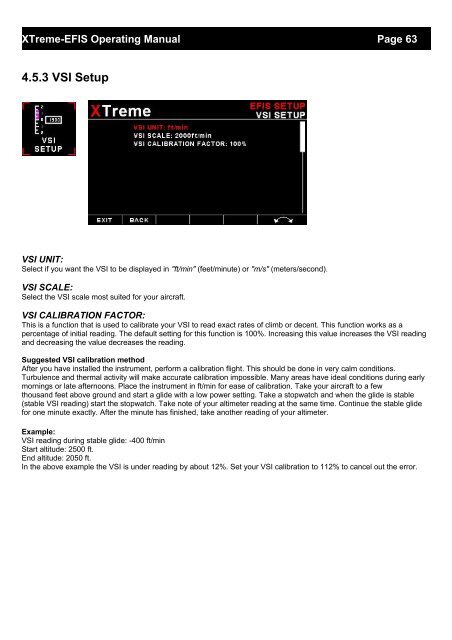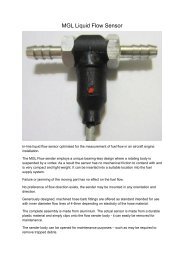XTreme EFIS - STRATOMASTER Instrumentation MGL Avionics
XTreme EFIS - STRATOMASTER Instrumentation MGL Avionics
XTreme EFIS - STRATOMASTER Instrumentation MGL Avionics
You also want an ePaper? Increase the reach of your titles
YUMPU automatically turns print PDFs into web optimized ePapers that Google loves.
<strong>XTreme</strong>-<strong>EFIS</strong> Operating Manual Page 63<br />
4.5.3 VSI Setup<br />
VSI UNIT:<br />
Select if you want the VSI to be displayed in "ft/min" (feet/minute) or "m/s" (meters/second).<br />
VSI SCALE:<br />
Select the VSI scale most suited for your aircraft.<br />
VSI CALIBRATION FACTOR:<br />
This is a function that is used to calibrate your VSI to read exact rates of climb or decent. This function works as a<br />
percentage of initial reading. The default setting for this function is 100%. Increasing this value increases the VSI reading<br />
and decreasing the value decreases the reading.<br />
Suggested VSI calibration method<br />
After you have installed the instrument, perform a calibration flight. This should be done in very calm conditions.<br />
Turbulence and thermal activity will make accurate calibration impossible. Many areas have ideal conditions during early<br />
mornings or late afternoons. Place the instrument in ft/min for ease of calibration. Take your aircraft to a few<br />
thousand feet above ground and start a glide with a low power setting. Take a stopwatch and when the glide is stable<br />
(stable VSI reading) start the stopwatch. Take note of your altimeter reading at the same time. Continue the stable glide<br />
for one minute exactly. After the minute has finished, take another reading of your altimeter.<br />
Example:<br />
VSI reading during stable glide: -400 ft/min<br />
Start altitude: 2500 ft.<br />
End altitude: 2050 ft.<br />
In the above example the VSI is under reading by about 12%. Set your VSI calibration to 112% to cancel out the error.

















